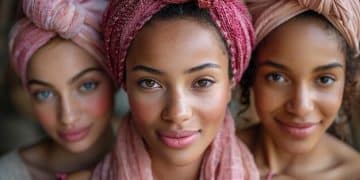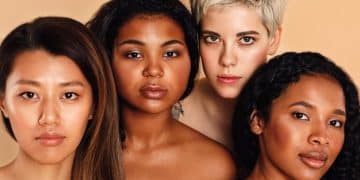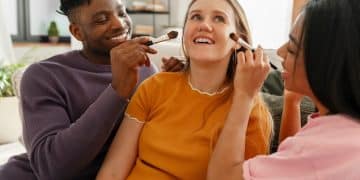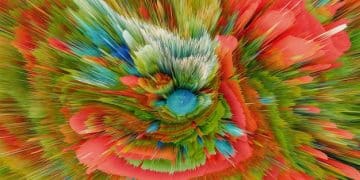Master Your Look: The Ultimate Guide to Choosing the Right Eyeshadow Palette for Your Eye Color
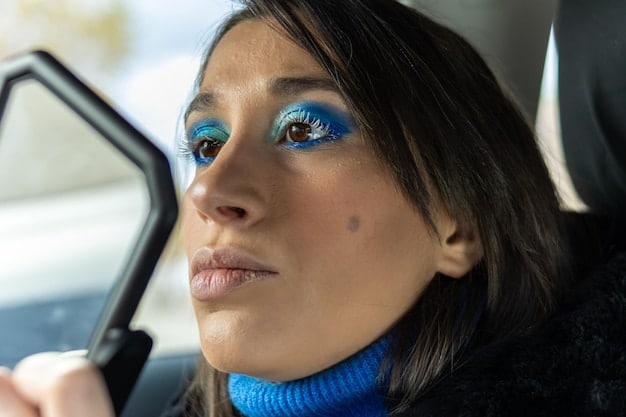
Anúncios
Choosing the right eyeshadow palette for your eye color involves understanding complementary shades, undertones, and desired effects to enhance natural beauty and create captivating looks suitable for any occasion.
Embarking on the journey to find the perfect eyeshadow palette can feel like navigating a vibrant, kaleidoscopic maze. With an overwhelming array of shades, finishes, and formulas, knowing how to choose the right eyeshadow palette for your eye color is crucial for unlocking your eyes’ full potential and creating truly captivating looks. This comprehensive guide will equip you with the knowledge to make informed choices, ensuring your eyeshadow not only complements your unique eye color but also enhances your overall appearance with sophistication and style.
The Science of Color: Understanding the Color Wheel for Eyeshadow
Diving into the world of eyeshadow begins with a fundamental understanding of color theory, specifically the color wheel. This artistic tool is invaluable when learning to select shades that truly make your eyes pop. It’s not just about what looks good on its own; it’s about how colors interact with each other to create harmony or contrast.
The color wheel organizes colors in a circle, illustrating their relationships. Understanding primary colors (red, blue, yellow), and how they mix to form secondary (green, orange, purple) and tertiary colors, is the first step. For eyeshadow, however, the most critical concept is that of complementary colors.
Complementary Colors: Your Eyeshadow Superpower
Complementary colors are those directly opposite each other on the color wheel. When placed side-by-side, they create the strongest contrast and cause each other to appear more vibrant. This principle is key to making your eye color stand out. For instance:
- Blue Eyes: Shades of orange, copper, and gold are directly opposite blue on the color wheel. These warm tones will make blue eyes appear more vivid and striking.
- Green Eyes: Reds and purples are complementary to green. Think about rich plums, burgundy, and even soft pinks to emphasize green eyes.
- Brown Eyes: Brown is a neutral color, often considered a mixture of all primary colors. This means brown eyes have the flexibility to look good with almost any shade. However, blues, purples, and greens often create the most captivating contrast.
- Hazel Eyes: Hazel eyes are unique, often containing flecks of green, brown, and gold. Shades that complement both green (purples, reds) and brown (blues, greens) can work beautifully. Warm browns, golds, and plum tones are particularly flattering.
By consciously choosing shades from the opposite side of the color wheel, you are leveraging color science to naturally enhance and brighten your eye color, making them the focal point of your makeup look. It’s a simple, yet highly effective technique used by professional makeup artists worldwide.
Beyond complementary colors, considering analogous colors (three colors next to each other on the color wheel) can also create harmonious and sophisticated looks. For example, a blue-eyed person could use blue, blue-green, and green shades for a soft, blended effect. This approach offers a less dramatic but equally beautiful enhancement.
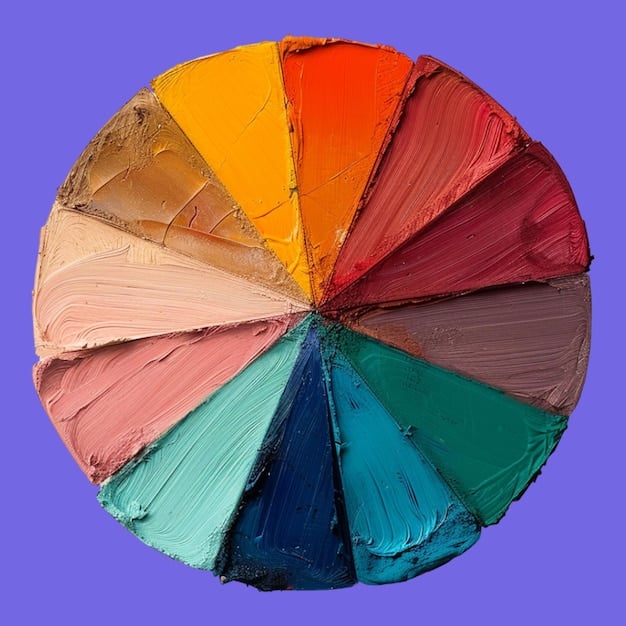
Navigating Your Eye Color: Specific Palette Recommendations
Now that we’ve covered the fundamentals, let’s get specific. Each eye color possesses a unique depth and undertone that can be beautifully highlighted by certain eyeshadow hues. This section breaks down recommendations for blue, green, brown, and hazel eyes, ensuring you pick a palette that truly elevates your natural beauty.
Best Eyeshadow Palettes for Blue Eyes
Blue eyes sparkle with cool undertones, making warm, earthy shades their perfect counterpart. To make blue eyes truly pop, focus on colors that provide a strong contrast, drawing attention to their coolness.
- Coppers and Golds: These metallic shades deliver warmth that beautifully contrasts with cool blue eyes, making them appear brighter and more intense.
- Oranges and Peaches: From soft peach to vibrant terracotta, orange-based shades are directly opposite blue on the color wheel and create a stunning effect.
- Browns: Warm browns with red or orange undertones, like reddish-brown or warm chocolate, add definition without overwhelming the blue.
- Neutrals with Warm Undertones: Think beige, taupe, and cream with a hint of warmth to create a soft, everyday look that still enhances your eye color.
Avoid highly cool-toned silvers or true blues that can sometimes make blue eyes appear muted instead of enhanced. The goal is contrast, not blending in.
Best Eyeshadow Palettes for Green Eyes
Green eyes, with their often mysterious and captivating quality, are beautifully enhanced by shades that bring out their golden or emerald flecks. Reds and purples are your go-to family.
- Plums and Burgundies: These deep, rich purples and reds create a dramatic contrast that intensifies the green hue.
- Violets and Lavenders: Softer purple shades can provide a more subtle enhancement, perfect for a daytime look.
- Bronze and Copper: Similar to blue eyes, warm metallics like bronze, copper, and gold provide a beautiful warmth that complements green and hazel eyes.
- Rose Gold and Pinks: Rosy tones, especially those with a subtle shimmer, can bring out the warmth in green eyes without being too overpowering.
Steer clear of greens that are too close to your eye color, as they might blend in rather than stand out. The exception would be a deep forest green for a monochromatic, intense look.
Best Eyeshadow Palettes for Brown Eyes
Brown eyes, versatile and rich, are lucky as they can pull off almost any color. However, certain shades can bring out specific undertones within brown, making them truly mesmerizing. Brown eyes often have flecks of gold, amber, or even green, which can be highlighted.
- Deep Blues and Teals: These cool tones create a striking contrast, making warm brown eyes appear even richer and more luminous.
- Purples and Violets: From light lavender to deep eggplant, purple shades are incredibly flattering and can bring out any hidden golden or amber flecks.
- Greens and Olives: Earthy greens, particularly those with a golden shimmer, can highlight the warmth in brown eyes and create a sophisticated, natural look.
- Golds and Bronzes: For true radiance, warm metallics intensify the richness of brown eyes and add a beautiful sparkle.
The beauty of brown eyes lies in their ability to handle a broad spectrum of colors. Feel free to experiment with bold shades like fuchsia or emerald for a high-impact statement.
Best Eyeshadow Palettes for Hazel Eyes
Hazel eyes are a chameleon, shifting between green, brown, and gold depending on the light and surrounding colors. This makes them incredibly fun to experiment with, as different shades can emphasize different aspects of their multi-tonal nature.
- Warm Browns and Golds: These shades enhance the inherent warmth in hazel eyes, bringing out golden and amber flecks.
- Plums and Burgundies: To emphasize the green in hazel eyes, plum and burgundy tones work wonders by providing a complementary contrast.
- Emerald Greens: If you want to bring out the green in your hazel eyes definitively, a deep, rich emerald green can do the trick.
- Coppers and Bronzes: These warm metallics are universally flattering on hazel eyes, adding depth and dimension.
When selecting shades for hazel eyes, consider what aspect you want to highlight. If you want to lean into the green, use purples. If you prefer to enhance the brown and gold, opt for warm neutrals and metallics.
Beyond Eye Color: Considering Undertones and Skin Tone
While eye color is a primary factor in choosing an eyeshadow palette, it’s not the only one. Your skin’s undertone, and even your hair color, can subtly influence how certain eyeshadow shades appear on you. Understanding these additional elements ensures your chosen palette truly flatters your entire complexion.
Determining Your Skin’s Undertone
Skin undertone refers to the subtle hue beneath the surface of your skin, which affects your overall complexion. There are three main undertones: cool, warm, and neutral. Knowing yours can help you select eyeshadows that harmonize with your skin, rather than clashing.
- Cool Undertones: Your skin has pink, red, or blueish hues. You might sunburn easily. Silver jewelry often looks better on you than gold.
- Warm Undertones: Your skin has golden, yellow, or peachy hues. You tend to tan easily. Gold jewelry often looks better on you.
- Neutral Undertones: Your skin has a balance of pink/red and yellow/golden tones. Both silver and gold jewelry typically suit you well.
A quick way to check your undertone is to look at the veins on your wrist in natural light. If they appear blue or purple, you likely have cool undertones. If they appear green, you likely have warm undertones. If you can’t tell, or they look both blue and green, you’re probably neutral.
How Undertones Affect Eyeshadow Choices
Once you know your undertone, you can use this information to refine your palette choices:
- Cool Undertones: Often look best with cool-toned eyeshadows like blues, purples, cool grays, rosy pinks, and cool-toned browns (taupes). These shades will complement the cool hues in your skin.
- Warm Undertones: Generally thrive with warm-toned eyeshadows such as coppers, golds, bronzes, peaches, warm browns, and olive greens. These colors will enhance the warmth in your complexion, making your skin look radiant.
- Neutral Undertones: You’re in luck! Neutral undertones can pull off both warm and cool shades with ease, offering the most versatility in eyeshadow choices.
While eye color remains a primary guide, factoring in your skin’s undertone ensures that your entire makeup look is cohesive and flattering. For example, a blue-eyed individual with warm undertones might lean towards warmer coppers and bronzes slightly more than pure oranges, as these shades will complement both their eye color and skin tone.
Beyond undertones, consider your personal style and desired intensity. Some people prefer subtle enhancements, while others love bold, dramatic statements. Your preferences should always guide your ultimate decision, allowing for self-expression through makeup.
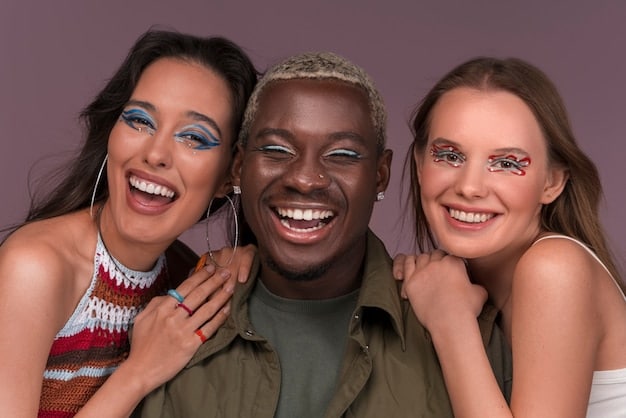
Formula, Finish, and Longevity: What Else Matters?
Beyond color, several other factors significantly impact the performance and appearance of an eyeshadow palette. The formula, finish, and longevity of the eyeshadows are crucial for achieving your desired look, whether it’s a subtle daytime shimmer or a dramatic evening statement.
Understanding Eyeshadow Formulas
Eyeshadows come in various formulations, each offering distinct benefits:
- Powder Eyeshadows: The most common type. They are easy to blend, buildable, and come in a vast range of colors and finishes. Ideal for creating layered looks and soft transitions.
- Cream Eyeshadows: Offer intense color payoff and tend to be long-wearing. They are best applied with fingers or a synthetic brush. Great for a quick, impactful wash of color or as a base for powder shadows.
- Liquid Eyeshadows: Provide a smooth, often high-shine finish. They dry down quickly and are very long-lasting, making them excellent for special occasions or when you need your makeup to stay put all day.
- Gel Eyeshadows: Similar to creams but often with a lighter, bouncier texture. They can be very versatile for both subtle and bold looks.
Consider your skill level and how much time you have for application when choosing a formula. Powder shadows are generally the most forgiving for beginners, while creams and liquids require a bit more practice for seamless application.
Exploring Different Finishes
The finish of an eyeshadow refers to its texture and how it reflects light. A single palette often includes a mix of finishes to allow for versatile looks:
- Matte: No shimmer or sparkle. Perfect for creating depth, contouring the eye, and setting bases. Essential for a complete, well-rounded look.
- Satin: A soft sheen, less reflective than shimmer but more than matte. Ideal for subtle everyday elegance and blending shades.
- Shimmer/Frost: Contains fine pearlescent particles that reflect light, giving a radiant glow. Great for highlighting the inner corner or center of the lid.
- Metallic: Highly reflective with a foil-like appearance. Delivers intense, vibrant color and a high-impact shine.
- Glitter: Contains larger glitter particles. Often used as a top coat to add sparkle and drama. Can sometimes have fallout, so a glitter primer is often recommended.
A good palette will offer a balance of these finishes. For instance, a few mattes for definition, a satin or two for transition, and a couple of shimmers or metallics for pop and highlight.
Longevity and Pigmentation
Beyond color and finish, consider how long the eyeshadow lasts and how intensely pigmented it is. A highly pigmented shadow means less product is needed for a strong color payoff, which can save you money and time. Longevity ensures your makeup stays fresh throughout the day without creasing or fading.
- Read reviews: Other users’ experiences can provide valuable insight into a palette’s quality.
- Swatches: Look for swatches online to see the true color and pigmentation.
- Consider a primer: An eyeshadow primer can significantly extend wear time and enhance color intensity for almost any formula.
Investing in a palette with a good range of reliable formulas and finishes ensures you have versatile options for any occasion and can create truly professional-looking eye makeup.
Palette Size vs. Versatility: Finding Your Perfect Match
When standing before a wall of eyeshadow palettes, one common dilemma arises: do you opt for a compact mini-palette or a sprawling mega-palette? The size of the palette often dictates its versatility, portability, and even how often you’ll reach for it. Finding your perfect match means considering your lifestyle, makeup habits, and specific needs.
The Appeal of Mini-Palettes
Mini-palettes typically contain 4-9 shades. Their compact size makes them incredibly convenient for travel, on-the-go touch-ups, or for those who prefer minimalist makeup routines. Often, these smaller palettes are curated around a specific color story or theme, making them cohesive and easy to use.
- Portability: Easily fits into a purse, travel bag, or even a small clutch.
- Curated Looks: Shades are often selected to create specific looks (e.g., a smoky eye mini-palette, or a nude everyday palette), simplifying decision-making.
- Less Overwhelm: For beginners or those who get overwhelmed by too many choices, a smaller selection can be less daunting.
However, the downside is often a lack of diverse finishes or a limited range of transition shades, which might necessitate owning multiple mini-palettes to cover all your bases.
The Power of Mega-Palettes
Mega-palettes, often featuring 12+ shades, offer a vast array of colors and finishes. These are the workhorses for makeup enthusiasts, professional artists, or anyone who loves to experiment with a wide variety of looks.
- Maximum Versatility: Can include mattes, shimmers, metallics, and even glitters, allowing for endless creative possibilities from natural to bold.
- Complete Color Stories: Often designed to provide all the shades needed to create numerous full eye looks within one palette.
- Value for Money: Per gram of product, larger palettes can sometimes offer better value than purchasing many single shadows or mini-palettes.
The drawback is their size, which makes them less travel-friendly. They can also be overwhelming for beginners, and you might find yourself only using a fraction of the shades regularly.
Finding Your Balance
The “right” size depends on you. If you primarily do one or two go-to eye looks, a mini-palette or two that perfectly suits your eye color and undertone might be ideal. This reduces clutter and ensures you use all the product you buy.
If you’re a makeup artist, enjoy diverse looks, or simply love having options, a larger, versatile palette will likely be a better investment. Consider a large neutral palette for everyday definitions and a smaller, more vibrant one for pops of color.
Ultimately, a balanced collection might include a versatile large neutral palette for daily use and a few smaller, more specialized palettes (e.g., a specific purple palette for green eyes, or a vibrant blue/gold palette for brown eyes) for when you want to experiment or create a specific statement look.
Application Techniques for Maximizing Your Palette’s Potential
Having the right eyeshadow palette is only half the battle; knowing how to apply it effectively is just as crucial. Proper application techniques can transform a good palette into an exceptional tool for enhancing your eye color and creating polished, professional-looking results. Mastering a few key techniques can make all the difference.
Essential Brushes and Their Uses
The right tools make eyeshadow application much easier and more precise. A basic set of brushes is a worthwhile investment:
- Fluffy Blending Brush: Essential for seamless transitions between colors and diffusing harsh lines. Use it for applying transition shades in the crease.
- Flat Shader Brush: Ideal for packing color onto the eyelid for maximum pigment payoff. Excellent for shimmer or metallic shades.
- Pencil Brush: Small and tapered, perfect for precise application in the inner corner, lower lash line, or for creating a smoky effect along the lash line.
- Angled Brush: Useful for applying eyeliner with powder eyeshadow or filling in brows.
Clean your brushes regularly to prevent bacteria buildup and ensure smooth application. Dirty brushes can lead to muddy colors and poor blending.
Layering and Blending for Depth
Layering and blending are the pillars of sophisticated eyeshadow application. This is where you build dimension and make your eye color truly shine.
- Primer First: Always start with an eyeshadow primer. This creates a smooth base, enhances color vibrancy, and significantly improves longevity, preventing creasing.
- Transition Shade: Apply a matte, neutral shade (often a light-to-medium brown or taupe) slightly darker than your skin tone into the crease. This creates a soft transition between your brow bone and eyelid.
- Lid Color: Apply your main lid color using a flat shader brush. For more intensity, spray your brush with setting spray before picking up shimmer or metallic shades.
- Crease Deepening: Use a slightly darker shade in the outer V and crease to add depth and dimension. Blend well with a fluffy brush to avoid harsh lines.
Remember, blend, blend, blend! The key to a polished look is the absence of any harsh lines between colors. Use light, circular motions with a fluffy brush to seamlessly meld shades together.
Highlighting and Defining Features
Strategic placement of certain shades can further enhance your eye color and shape:
- Inner Corner Highlight: A light, shimmery shade in the inner corner of the eye brightens and opens up the eyes, making them look more awake.
- Brow Bone Highlight: A matte or satin light shade under the arch of your brow lifts and defines the brow bone, creating a clean finish.
- Lower Lash Line: Extending a small amount of your lid or crease color to the lower lash line creates a cohesive and more impactful look. Use a pencil brush for precision.
By integrating these application techniques, you can transform your eyeshadow palette from a collection of colors into a powerful tool for self-expression and enhancing your natural beauty. Practice makes perfect, so don’t be afraid to experiment!
Maintaining Your Eyeshadow Palettes: Tips for Longevity
Eyeshadow palettes are an investment, and like any beauty product, they require proper care to ensure their longevity, hygienic use, and optimal performance. Neglecting palette maintenance can lead to shortened shelf life, product contamination, and diminished color payoff. By following a few simple tips, you can keep your palettes pristine and productive for longer.
Keeping Your Palettes Clean
Cleanliness is paramount for both the health of your eyes and the integrity of your eyeshadows. Bacteria can easily transfer from your fingers or brushes to your palette, leading to potential eye infections and product degradation.
- Regular Brush Cleaning: This is arguably the most important step. Clean your eyeshadow brushes after every few uses (or ideally, after each use if you’re a professional) with a gentle brush cleanser or mild soap and water. Ensure they are fully dry before use.
- Wipe Down Surfaces: Periodically wipe the surface of your eyeshadow pans and the palette’s casing. Use a gentle, alcohol-free wipe or a cotton pad dampened with rubbing alcohol to remove any oils, product residue, or buildup. For powder shadows, gently wipe away any top layer that appears hardened or shiny (known as “hard pan”), as this can hinder pigment pickup.
Hard pan occurs when oils from your skin or products transfer to the powder, creating a film. Gently scraping it off with a clean spoolie or a piece of tape can restore the shadow’s texture.
Proper Storage and Handling
How you store and handle your palettes also greatly impacts their lifespan. Exposure to extreme conditions or rough handling can ruin your precious powders.
- Store in a Cool, Dry Place: Heat and humidity are enemies of powder makeup. Avoid storing palettes in bathrooms, which can get steamy, or near windows where they might be exposed to direct sunlight. A cool, dry drawer or cabinet is ideal.
- Keep Lids Closed: Always close the palette lid tightly after use. This prevents dust and debris from accumulating on the shadows and helps to maintain the product’s texture and prevent it from drying out prematurely.
- Handle with Care: Eyeshadows, especially pressed powders, can be fragile. Avoid dropping your palettes, as this can cause the pans to shatter. Use a protective case if you travel frequently.
By adopting these simple maintenance habits, your eyeshadow palettes will remain vibrant, easy to use, and hygienic, providing you with endless opportunities to create stunning eye looks for years to come. A well-cared-for palette performs better and lasts longer, making your beauty investment truly worth it.
Embracing Experimentation and Personal Style
While guidelines based on eye color and undertones provide an excellent starting point for choosing eyeshadows, the world of makeup is ultimately about creativity, self-expression, and fun. Don’t let rules restrict your artistic inclinations. The true magic happens when you embrace experimentation and allow your personal style to shine through, regardless of conventional wisdom.
Breaking the Rules (Gently)
Sometimes, the most stunning looks come from breaking away from strict color theory. For instance, a cool-toned blue on blue eyes, while not directly complementary, can create a striking, monochromatic effect that is incredibly modern and chic. Similarly, a vibrant pink might not be the obvious choice for brown eyes, but it can create a bold, playful statement.
- Try Analogous Colors: Instead of strict complementary colors, experiment with analogous colors (colors next to each other on the color wheel). This creates harmonious, sophisticated looks that are less about contrast and more about subtle blending.
- Incorporate Pop Colors: Don’t be afraid to add a “pop” of an unexpected color. For example, a small touch of bright green eyeliner on blue eyes, or a subtle yellow in the inner corner of brown eyes, can add an exciting twist without overwhelming.
- Focus on Finish and Texture: Even if a color isn’t a “perfect” match, a beautiful finish (like a dazzling metallic or a rich matte) can make it work. Experiment with different textures to see how they impact your look.
The best way to discover what works for you is simply to try it. Makeup is temporary, and washes off, so there’s no real risk in playing around with different shades and combinations.
Confidence is Your Best Accessory
Ultimately, the most flattering eyeshadow is the one you feel confident wearing. When you love your look, it shows. Your confidence will make any color look good, regardless of whether it perfectly adheres to color theory principles. Makeup is a tool for self-confidence and self-expression, not a rigid set of rules.
- Trust Your Instincts: If a color calls to you, try it! Your intuition can often guide you to shades you’ll genuinely enjoy.
- Consider the Occasion: Save the boldest experiments for less formal settings. For a professional environment, you might stick closer to the “rules,” but for a night out, the sky’s the limit.
- Seek Inspiration: Look at photos of people with similar eye colors and skin tones but also be inspired by diverse looks on social media and magazines. Adapt ideas rather than directly copying them.
Embracing personal style means understanding that makeup is a journey of discovery. Your preferences may evolve, and new trends will emerge. By staying open to exploration while armed with fundamental knowledge, you can continually refine your technique and expand your creative horizons. The most exciting and beautiful eyeshadow looks are often those that defy expectations.
| Key Aspect | Brief Explanation |
|---|---|
| 👁️ Complementary Colors | Use the color wheel to find shades opposite your eye color for maximum pop. |
| 🎨 Skin Undertone | Cool, warm, or neutral undertones influence which shade temperatures flatter your complexion. |
| ✨ Formula & Finish | Powders, creams, mattes, and shimmers create different effects and suit various skill levels. |
| 🔍 Personal Style | Don’t be afraid to experiment and break traditional rules for unique looks. |
Frequently Asked Questions About Eyeshadow Palettes
Yes, many neutral eyeshadow palettes contain shades like browns, golds, and bronzes that are universally flattering across various eye colors. These palettes often emphasize definition and warmth rather than direct complementary contrast, making them versatile. Look for palettes with a good mix of matte and shimmer neutral tones.
To ensure your eyeshadow lasts all day without creasing, always start with an eyeshadow primer. A good primer creates a smooth, even base, enhances color payoff, and creates a barrier that prevents oils from your eyelids from breaking down the eyeshadow. Applying a thin layer is usually sufficient for optimal results.
A transition shade is a matte eyeshadow color, usually a few shades darker than your skin tone, applied into the crease of your eyelid. It’s crucial for seamlessly blending darker shades and creating a soft, diffused gradient between colors. It helps prevent harsh lines and ensures a polished, professional-looking eye makeup application.
Not necessarily. While high-end palettes often boast superior pigmentation and blendability, many affordable brands now offer excellent quality eyeshadows. It’s more about researching reviews, swatches, and focusing on specific formulas and shades that perform well. Price doesn’t always guarantee better performance; some affordable options truly shine.
For optimal hygiene and performance, it’s recommended to clean your eyeshadow brushes weekly if you use them regularly. If you use them daily or for multiple clients, consider cleaning them after each use. Regular cleaning prevents product buildup, ensures smoother application, and reduces the risk of bacterial transfer to your eyes.
Conclusion
Choosing the right eyeshadow palette for your eye color is a blend of art and science, harmonizing color theory with personal preference. By understanding the nuances of complementary shades, considering your skin’s undertones, and selecting appropriate formulas and finishes, you can unlock a world of possibilities to enhance your natural beauty. Remember that while guidelines are helpful, true artistry lies in confident experimentation and allowing your unique style to shine through. The perfect palette is ultimately the one that makes you feel amazing and ready to conquer the day.
